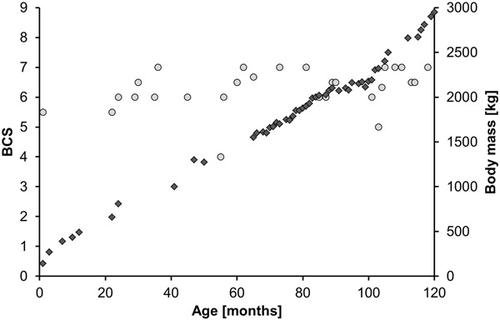Our official English website, www.x-mol.net, welcomes your feedback! (Note: you will need to create a separate account there.)
Weigh and see—Body mass recordings versus body condition scoring in European zoo elephants ( Loxodonta africana and Elephas maximus )
Zoo Biology ( IF 1.3 ) Pub Date : 2020-03-01 , DOI: 10.1002/zoo.21525 Christian Schiffmann 1 , Marcus Clauss 1 , Stefan Hoby 2, 3 , Jean-Michel Hatt 1
Zoo Biology ( IF 1.3 ) Pub Date : 2020-03-01 , DOI: 10.1002/zoo.21525 Christian Schiffmann 1 , Marcus Clauss 1 , Stefan Hoby 2, 3 , Jean-Michel Hatt 1
Affiliation

|
Regular body mass (BM) monitoring plays a key role in preventative health care of zoo animals. In some species, including African (Loxodonta africana) and Asian elephants (Elephas maximus), the process of weighing can be challenging, and alternative methods such as visual body condition scoring (BCS) have been developed. We investigated the temporal development of both parameters regarding correlation patterns between them, and their suitability as monitoring measures in dependence of an elephant's life stage. While BM is more suitable in calves and juveniles under the age of 8 years, both BM and BCS are considered equally reliable in adult elephants. In elephants over the age of 40 years, BCS might be more suitable for assessing the physical status. Independent of species and sex, juvenile zoo elephants grow in BM nearly linearly with age, and reach a higher BM at an earlier age compared with conspecifics of free-ranging and semi-captive populations in the countries of origin. The BCS typically remains constant during this life stage, seemingly unaffected by growth. In adult animals, breeding females have a lower BM and BCS than nonbreeders, and BM and BCS typically indicate fluctuations in the same direction. In geriatric elephants (>40 years) a drop in BCS occurs commonly, while BM may even increase in this life stage. We recommend regular body mass recording in zoo elephants to enhance our knowledge of body mass development and allow the formulation of objective practical recommendations. BCS presents a valuable and simple tool for complementary monitoring of an elephant's condition, especially in adult and geriatric individuals.
中文翻译:

称重并查看 - 欧洲动物园大象(非洲象属和大象象)的体重记录与身体状况评分
定期体重 (BM) 监测在动物园动物的预防保健中起着关键作用。在某些物种中,包括非洲象(非洲象属)和亚洲象(大象),称重过程可能具有挑战性,并且已经开发了替代方法,例如视觉身体状况评分 (BCS)。我们调查了关于它们之间相关模式的两个参数的时间发展,以及它们作为依赖于大象生命阶段的监测措施的适用性。虽然 BM 更适合小象和 8 岁以下的幼象,但 BM 和 BCS 在成年象中被认为同样可靠。对于 40 岁以上的大象,BCS 可能更适合评估身体状况。与物种和性别无关,幼年动物园大象在 BM 中的生长几乎与年龄呈线性关系,与原产国的自由放养和半圈养种群的同种种群相比,在更早的年龄达到更高的 BM。BCS 在这个生命阶段通常保持不变,似乎不受生长的影响。在成年动物中,繁殖雌性的 BM 和 BCS 比非繁殖者低,BM 和 BCS 通常表示在同一方向上的波动。在老年大象(> 40 岁)中,BCS 通常会下降,而 BM 在这个生命阶段甚至可能会增加。我们建议定期记录动物园大象的体重,以增强我们对体重发展的了解,并允许制定客观的实用建议。BCS 提供了一种有价值且简单的工具,用于补充监测大象的状况,尤其是在成年和老年个体中。
更新日期:2020-03-01
中文翻译:

称重并查看 - 欧洲动物园大象(非洲象属和大象象)的体重记录与身体状况评分
定期体重 (BM) 监测在动物园动物的预防保健中起着关键作用。在某些物种中,包括非洲象(非洲象属)和亚洲象(大象),称重过程可能具有挑战性,并且已经开发了替代方法,例如视觉身体状况评分 (BCS)。我们调查了关于它们之间相关模式的两个参数的时间发展,以及它们作为依赖于大象生命阶段的监测措施的适用性。虽然 BM 更适合小象和 8 岁以下的幼象,但 BM 和 BCS 在成年象中被认为同样可靠。对于 40 岁以上的大象,BCS 可能更适合评估身体状况。与物种和性别无关,幼年动物园大象在 BM 中的生长几乎与年龄呈线性关系,与原产国的自由放养和半圈养种群的同种种群相比,在更早的年龄达到更高的 BM。BCS 在这个生命阶段通常保持不变,似乎不受生长的影响。在成年动物中,繁殖雌性的 BM 和 BCS 比非繁殖者低,BM 和 BCS 通常表示在同一方向上的波动。在老年大象(> 40 岁)中,BCS 通常会下降,而 BM 在这个生命阶段甚至可能会增加。我们建议定期记录动物园大象的体重,以增强我们对体重发展的了解,并允许制定客观的实用建议。BCS 提供了一种有价值且简单的工具,用于补充监测大象的状况,尤其是在成年和老年个体中。



























 京公网安备 11010802027423号
京公网安备 11010802027423号